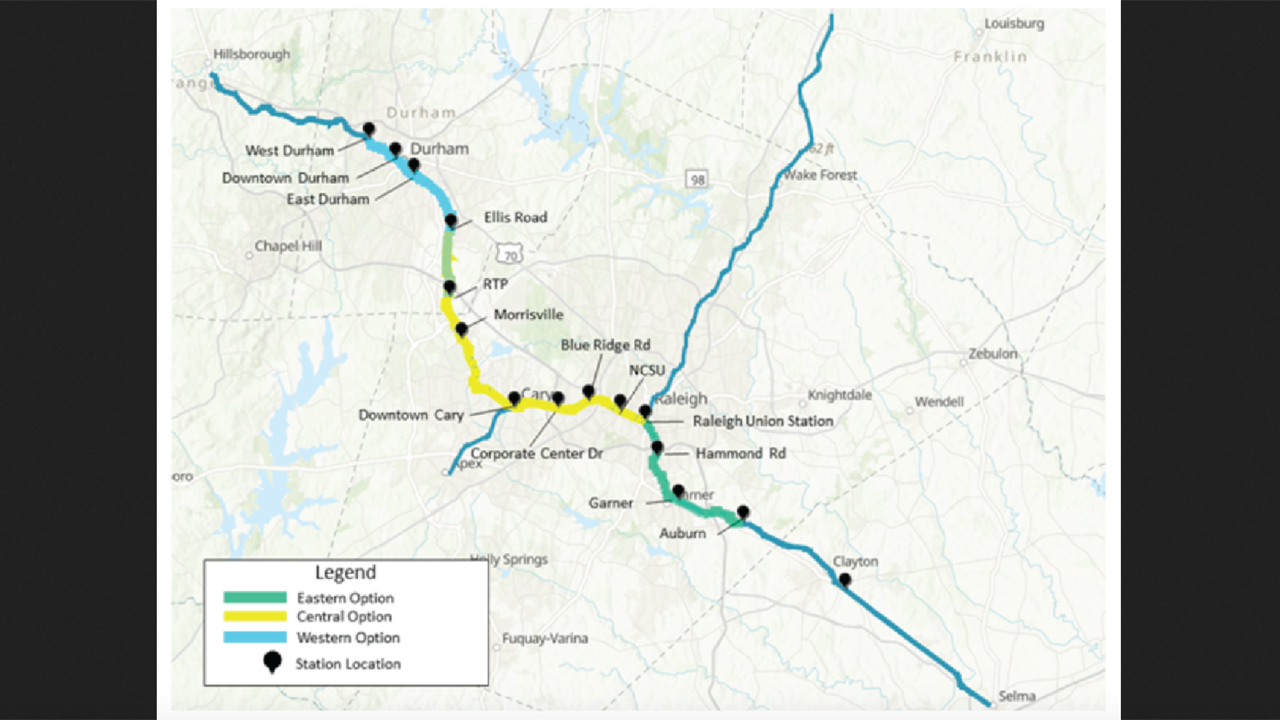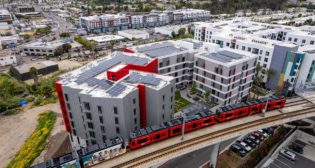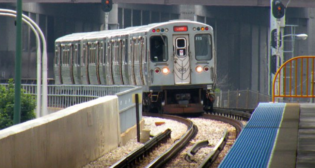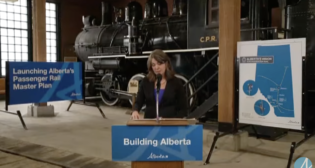
Transit Briefs: GoTriangle, WMATA, CTA
Written by Carolina Worrell, Senior Editor
GoTriangle’s proposed commuter rail line between Durham and Garner, N.C., has been shelved for now as the Authority focuses on a longer-term approach. Also, the Washington Metropolitan Area Transit Authority (WMATA) advances sustainability and climate change solution with new bonds to modernize the transit system; and the Chicago Transit Authority (CTA) highlights progress one year after launching “Meeting the Moment” plan.
GoTriangle
Six months after GoTriangle completed the Greater Triangle Commuter Rail Feasibility Study, the idea to bring a commuter rail line between Durham and Garner, N.C., has been shelved “but there are steps that local and state governments can take in the coming years to make a regional passenger rail line more likely in the future,” according to a News Observer report.
According to the report, federal officials have indicated that they won’t help pay to build such a system now. “There aren’t enough people living along the rail corridor for the project to qualify for federal construction money,” said Sig Hutchinson, the former Wake County Commissioner who heads the GoTriangle Board.
“But the project remains a long-term goal,” Hutchinson said. At his urging, the GoTriangle board voted last week to endorse the idea, outlined in the feasibility study, of eventually running passenger trains along 37 miles of an existing railroad corridor between Durham, Research Triangle Park, Cary, Raleigh and Garner, according to the News Observer report.
“We are still 100% committed to regional passenger rail,” Hutchinson said.
But, according to the report, it won’t happen any time soon. “Without federal support, Triangle governments would need to find the entire $3 billion or more to build the system, something they’ve indicated is ‘not palatable,’” said GoTriangle CEO and President Charles Lattuca. “What’s coming back to us is, let’s take a longer-term approach. Let’s see what we can do with small projects, smaller bites, to achieve a project later that will be less costly.”
According to the News Observer report, many of those smaller projects are steps the North Carolina Department of Transportation (NCDOT) or local governments want to do anyway to make the rail corridor safer or improve conditions for Amtrak and freight trains. These include upgrading signals, adding tracks and sidings or improving passenger stations. Lattuca noted that GoTriangle and Durham County are studying how to eliminate three dangerous rail crossings in East Durham, by either closing them or building bridges or underpasses. “If we can do that, that’s going to make a future passenger rail project much more feasible and cheaper,” he said.
WMATA
WMATA announced Aug. 25 that it is “advancing its mission to be part of the region’s solution on sustainability and climate change” by selling bonds, that, for the first time, have secured a Sustainability–Climate Transition designation, meaning they will be used to “fund projects with environmental benefits and contribute a positive social benefit,” according to the agency.
According to WMATA, issuing bonds is an important part of the agency’s strategy “to maintain a predictable revenue stream to plan for long-term capital projects that modernize the system and keep it safe and reliable for generations to come.” The Sustainability–Climate Transition Bonds designation is issued by the International Capital Market Association (ICMA).
The $797,800,000 bond sale, which settled Aug. 17, will fund capital projects across WMATA’s approved FY24 Capital Improvement Plan, including but not limited to: automatic train control equipment upgrades, traction power upgrades, work on Metro’s existing fleet of trains and its next generation of railcars, rail station LED lighting improvements, bus garage rehab and replacements, and bus fleet replacement and zero emission bus transition.
WMATA says its biggest sustainability impact for the region is in the service it provides— “efficient, low-carbon transportation that allows many in the region to have low-or no-car households.” In 2022, Metro customers traveled 760,000,000 miles on bus and rail, reducing tailpipe emissions by 240,000 metric tons if those miles would have otherwise been traveled by car, according to the agency.
Sustainability–Climate Transition Bonds require that bond proceeds are used exclusively to fund projects with environmental and social benefits—and WMATA’s entire capital program qualifies, according to the agency. The ICMA has established standards for determining project eligibility, tracking bond proceeds and reporting on project impact. WMATA worked with BLX Group LLC, an independent municipal consulting and compliance advisory firm, for rigorous verification of Sustainability–Climate Transition bond designation eligibility.
Issuing these bonds, WMATA says, align with the agency’s continuing commitment to sustainability. As outlined in its Strategic Transformation Plan, WMATA’s mission of “connecting you to possibilities” and its vision of being the “region’s trusted way to move more people safely and sustainably” align with ICMA’s Sustainability Bond Principles. For example, this year WMATA advanced equitable access to transit by capping MetroAccess fares at $4 and establishing MetroLift program for low-income households. And WMATA’s plan to transition its bus fleet to 100% zero-emission by 2042 supports ICMA’s Climate Transition Bond Principles by advancing low-carbon transportation to achieve the 2-degree Celsius warming limit established by the Paris Climate Agreement.
“Choosing Metro has always been one of the most beneficial choices you can make for sustainability and the environment, and these new bonds further solidify Metro as a leader in sustainability for the region and an attractive investment for the bond market,” said Metro General Manager and CEO Randy Clarke.
“Metro’s capital program is delivering large-scale projects to modernize our system on time and on budget, and these bonds will help us continue to improve our system,” said Metro Board Finance and Capital Committee Chair Matt Letourneau. “Metro not only connects our region, but also reduces emissions and improves the environment, which allowed us to secure the Sustainability-Climate Transition designation for these bonds.”
CTA
CTA on Aug. 25 announced that in the year since President Dorval R. Carter, Jr. unveiled the “Meeting the Moment: Transforming CTA’s Post-Pandemic Future” Action Plan, “measurable progress has been made in each of the five guiding pillars outlined in the plan,” according to the agency.
“Since I announced our ‘Meeting the Moment’ plan last year, we’ve made noticeable improvements to virtually every aspect of our riders’ experience,” Carter said. “And while we are encouraged by the progress we’ve seen since implementing a variety of new initiatives, we know there’s still more work to be done.”
According to CTA, nearly every measure outlined for each of the five guiding pillars in the Meeting the Moment plan has been implemented, “helping drive positive results for both CTA riders and employees”:
Deliver Reliable and Consistent Service
CTA is providing a higher percentage of rail service since implementing optimized schedules, which also allowed the agency to provide more consistent service with the available workforce.
- Average rail service delivered in July 2023: 88.4%, compared to August 2022: 71.8%—a 22% improvement.
As part of its ongoing commitment to transparency and keeping customers informed of operations, CTA now offers an improved, expanded and interactive tool to track the agency’s performance. The new Performance Metrics report, which is updated monthly, is an interactive dashboard that measures multiple areas of performance—from ridership numbers to operator headcount, elevator and escalator up-time and availability of rail fleet for service.
According to CTA, “unprecedented and aggressive steps” have also been taken to strengthen the workforce, which is central to providing more consistent and reliable service, including:
- Offering new hiring and retention incentives.
- Employing retired rail instructors to assist with the training of the more than 40 new rail operators hired so far in 2023.
- Increasing the starting wages for rail operators and mechanics.
- Partnering with Olive-Harvey College to offer a free preparatory course to assist candidates in meeting the hiring requirement of obtaining a Commercial Learner’s Permit (CLP).
Enhance Safety and Security for Riders
Key safety and security initiatives implemented as part of the “Meeting the Moment” plan include:
- Deployment of 50 two-person teams with K-9 units to complement efforts by the Chicago Police Department (CPD), which provides law enforcement for CTA.
- Installation of video monitors in the station Customer Assistant Booth(s) providing real-time views of station cameras.
- Invested $2 million to expand social service engagement efforts for those seeking shelter on the system and/or struggling with mental health or substance abuse.
According to the latest statistics released by CPD, thanks to the ongoing collaborative efforts, crimes decreased across the board during the month of July:
- Overall transit crime was down 9% year to date, and 21% compared to July 2022.
- Violent crime was down 13% year to date, and 21% versus July 2022.
Improve the Customer Experience at CTA Facilities
CTA’s already extensive cleaning protocols were further enhanced as part of the Action Plan, and other improvements were made across CTA facilities to improve the customer experience, including:
- Completing Refresh & Renew station improvements at 28 locations across all rail lines in 2022, with plans to complete work at 29 stations in 2023.
- Adding 50 additional personnel as part of the 2023 “Goodbye Grime” campaign featuring stepped-up station cleaning measures that include power washing, scrubbing of surfaces, debris clean-up, and more.
- Power washing all 145 rail stations at least once a month between spring and fall months (such work cannot be performed during the winter due to freezing).
- Coordination with the Chicago Department of Aviation to modernize the traveler experience at O’Hare Blue Line station with new and enhanced signage and wayfinding.
- Testing and introducing the newest generation of railcars—the 7000-Series; more than 40 railcars have been added to the fleet.
Under “Meeting the Moment,” CTA continued to improve and invest in rail infrastructure to bring the system to a state of good repair, speed up trains, and elevate customer experience, including:
- Launching the Forest Park Branch Rebuild—a multi-phased, multi-year program to make service along the entire branch faster, safer, more reliable and accessible for riders.
- As part of Phase 1 work which is underway through early-October, crews have been working around the clock to replace the Blue Line tracks between LaSalle and Illinois Medical District and are completely rebuilding the Racine station to make it wheelchair accessible.
- Advancing the “All Stations Accessibility Program” to make all CTA rail stations accessible by the year 2038. So far, funding has been secured for 14 of the remaining 42 inaccessible stations – all of which are various stages of planning.
Upgrade Digital Tools to Improve Rider Communication
According to CTA, efforts are also under way to improve and upgrade the tools provided for the agency’s riders so that they are better informed and have the latest and more reliable service information. Among the measures taken so far to improve the customer digital information tools are:
- Lowering instances of “ghost” trains through ongoing enhancements to CTA Train Tracker feeds and schedule optimization efforts.
- Offering a new livestreaming tool that provides real-time information on platform crowding conditions during the AM commute for Blue Line riders using select stations on the O’Hare branch.
Investing in Employees
CTA says it is committed to investing in its exiting workforce and attracting new employees in this competitive market. As part of the “Meeting the Moment” plan, CTA leadership worked with the union leadership to advance competitive hiring and retention strategies including:
- All new rail car repairers hired in 2022 and 2023 will receive or have received a $1,000 hiring bonus.
- Eligible employees represented by the ATU Locals began receiving retention incentive payments after every six-month period worked, starting July 1, 2022 through December 2023. The incentive is equal to 3 percent of their hourly rate for actual hours worked, up to a maximum of 1,250 hours per six-month period.
- Provided CSAs with video screens to better monitor station activities.
- Expanded employee recognition programs.
- Improved the SAFELINE anonymous internal reporting system for employees to report potential workplace hazards.



